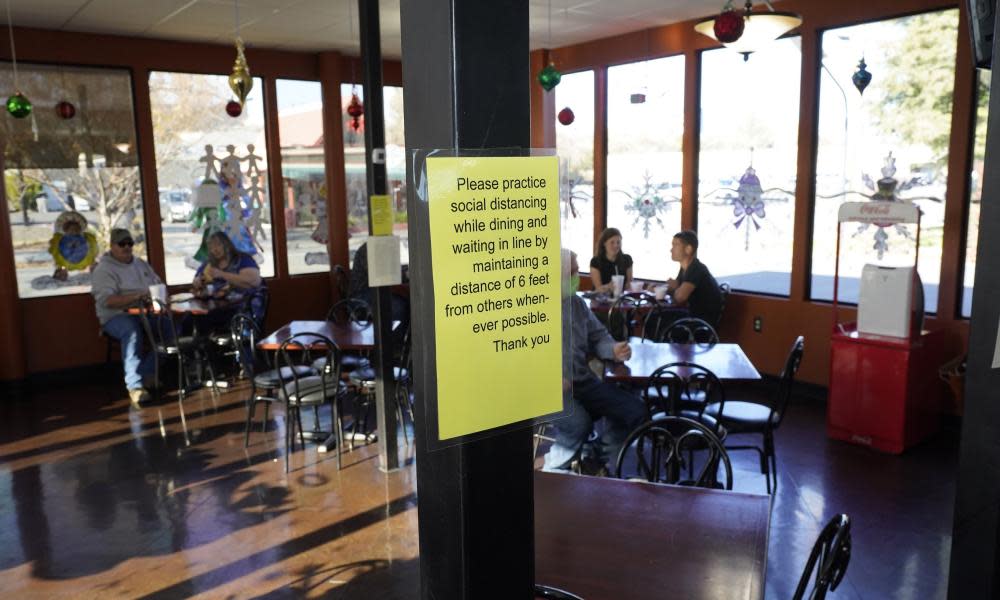‘Waiting to happen’: the California region where masks are taboo – and cases are rising

Rural northern California is seeing a troubling rise in Covid-19 cases and hospitalizations, an alarming trend that comes as residents and businesses continue to protest against safety measures and vaccinations – with one Mendocino cafe threatening to charge customers $5 for wearing a mask.
While the region makes up a small proportion of the state’s population, the growth in its caseload has been considerable, and comes at a time when the state overall is enjoying some of the lowest rates of Covid in the country. After largely avoiding the worst of the pandemic, a block of far northern California counties now leads the state with nearly 40 cases per 100,000 residents over the past week, according to statistics maintained by the Los Angeles Times. Tehama county ranked the highest in the LA Times case ratings with 139 cases per 100,000 residents. Meanwhile 10 of the 21 total Covid deaths in nearby Siskiyou county have occurred since the beginning of May.
Related: ‘Our society is totally nuts’: Fauci emails lift lid on life in eye of the Covid storm
The region has long been one of the most forceful in its pushback against measures such as masks, business restrictions and vaccine mandates – and the protests have only continued to gain steam. A cafe in the town of Mendocino made headlines after announcing it will charge customers a $5 fee if they order while wearing a mask. It also threatened to charge $5 to anyone “caught bragging about your vaccine”.
“It’s about time the proponents of these ineffective government measures start paying for the collateral damage they have collectively caused,” the cafe owner Chris Castleman told NBC News. He also offered a 50% discount to customers who threw their masks in the trash.
George Rutherford, a professor of epidemiology at the University of California, San Francisco, said the current situation feels inevitable. “I was waiting for this to happen,” he said, adding that the outbreaks mirror trends occurring in southern and eastern Oregon, just north of California’s border. “It shows you where vaccination is lagging and transmission is taking place.”
Kerri Schuette, the program manager of Shasta county’s public health department, said her county had seen jumps in cases and hospitalizations since mid-May, but new cases have come down a bit since last week.
“We are hopeful that this last jump won’t lead to more deaths,” she said. “But our hospitalizations have increased, so that is concerning.”
About 43% of Californians statewide have been vaccinated, but residents in the north have been slower to adopt. In Tehama, Del Norte and Lassen counties, vaccination rates are among the worst in the state with only about a quarter of the population having received their full doses, according to data provided by the New York Times.
“We are working to address vaccine hesitancy,” said Schuette of Shasta’s 30% vaccination rate.
At the same time, she said residents were rapidly abandoning the precautions urged by health officials.
“Our adherence to masking and social distancing measures has dramatically dropped,” she said. “And it was never great to begin with.”
The region has been a hotbed of protest against the closures and restrictions implemented by the state’s governor, Gavin Newsom, which were some of the earliest and most stringent in the US. The backlash has had political consequences – currently three supervisors in Shasta county are being threatened with recalls for supporting Covid safety measures, and the county’s meetings are regularly mobbed with protesters calling for an end to business restrictions and mask-wearing.
California law still requires masks to be worn in all indoor spaces outside the home, including businesses. The state expects a change in rules will come with the governor’s promised reopening of the state on 15 June.
Rutherford noted that the population in these northern counties was too small to have a major effect on the state’s numbers, but worried that transmission could stubbornly linger in these areas.
Even if nearby regions, such as the San Francisco Bay Area, achieve herd immunity with vaccination rates as high as 80% to 90%, as long as the virus continues to find new people to infect, it will never really disappear, he said.
“There’s going to be residual people who just won’t get vaccinated,” he said. “That can sustain transmission in the population. Those counties may not have enough vaccination to achieve herd immunity.”

